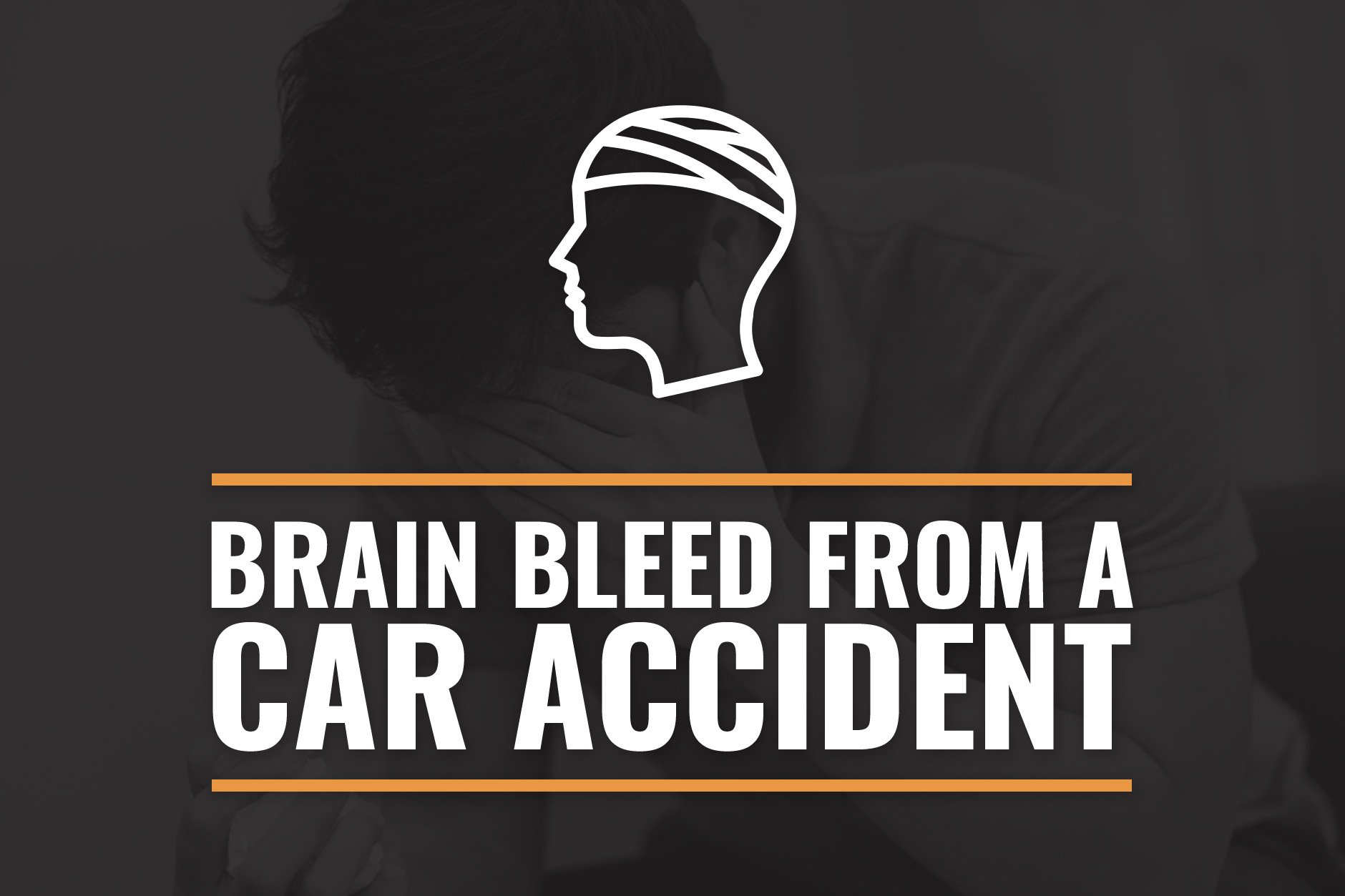
Table of Contents
According to the Centers for Disease Control and Prevention, motor vehicle accidents are a leading cause of traumatic brain injuries. But unlike cuts, lacerations, or broken bones, these injuries aren’t always obvious right away. You might leave the scene feeling sore but otherwise fine, only to develop severe headaches, confusion, or other alarming symptoms hours or days later.
In some cases, those symptoms point to a brain bleed, which happens when blood collects inside your skull and puts pressure on your brain. Without fast medical care, a brain bleed can cause permanent disability or death. In this guide, we’ll explain what these injuries are, how they happen in car accidents, and how an experienced Michigan personal injury lawyer can help you protect your right to compensation.
What is a Brain Bleed?
A brain bleed, also called an intracranial hemorrhage, is a collection of blood inside the skull caused by internal vessel damage. It can form in one location or across multiple areas. Depending on the location, the bleeding may compress certain parts of the brain and cause different symptoms. The real danger is that bleeding often continues while pressure builds, so prompt medical evaluation is critical, even if you feel fine immediately after the crash.
How Car Accidents Can Cause Brain Bleeds
A car accident can cause a brain bleed through direct and indirect forces. While both can damage delicate blood vessels in the brain, they differ in how the injury occurs and in the circumstances that make them more likely to happen.
- Direct Forces: With direct forces, your head makes contact with a hard surface inside or outside the vehicle, such as the windshield, steering wheel, dashboard, or door frame. The impact can cause immediate vascular damage at the point of contact, leading to bleeding in or around the brain.
- Indirect Forces: Indirect forces mean that your head didn’t actually strike any object. They result from rapid acceleration or deceleration that causes the brain to move within the skull. This motion can stretch or tear small blood vessels, creating internal bleeding even when there is no visible head injury.
The likelihood of a brain bleed increases in high-speed impacts, during vehicle rollovers, or when a person is ejected from the car. Even at lower speeds, concentrated force can cause dangerous bleeding, particularly in children, older adults, and those with medical conditions that affect blood clotting or vessel strength. These factors can make the brain more vulnerable to injury, even in collisions that may appear minor.
Types of Brain Bleeds From Car Accidents
A brain bleed can happen in several locations within the skull. The site of the bleeding affects how quickly symptoms develop, the severity of the injury, and the type of treatment required. Here are the four main types of brain bleeds most commonly diagnosed after a collision.
Subdural Hematoma
A subdural hematoma develops when veins between the brain’s surface and the dura mater (its outer covering) are torn. This tends to happen when rapid acceleration or deceleration causes the brain to shift inside the skull, stretching these vessels until they rupture. Bleeding in this space can build pressure over hours or days, leading to symptoms such as headache, confusion, and weakness on one side of the body. Large subdural hematomas can become medical emergencies requiring surgery to remove the accumulated blood.
Epidural Hematoma
An epidural hematoma occurs when bleeding develops between the inside of the skull and the dura mater. This type is usually the result of a direct blow that fractures the skull and damages an artery. Symptoms can progress quickly, sometimes beginning with a brief loss of consciousness, followed by a temporary period of alertness before rapid deterioration. Without immediate surgical intervention, an epidural hematoma can be fatal.
Intracerebral Hemorrhage
With an intracerebral hemorrhage, the bleeding goes directly into brain tissue. This can happen when the force of a crash damages small arteries deep within the brain. Depending on the location, the bleed may affect movement, speech, or sensory processing. Intracerebral hemorrhages can vary in size and severity, and treatment normally involves a combination of surgery, medication, and rehabilitation.
Subarachnoid Hemorrhage
A subarachnoid hemorrhage happens when bleeding develops in the space between the brain and the arachnoid membrane (the thin tissue that covers it). In car accidents, this type of injury results from trauma that damages surface blood vessels. One of the hallmark symptoms is a sudden, severe headache, sometimes described as the worst headache a person has ever experienced. Additional symptoms may include nausea, vision changes, and loss of consciousness. Treatment focuses on controlling bleeding, preventing complications, and managing pressure inside the skull.
Common Causes of Brain Bleeds in Car Accidents
Any motor vehicle accident can cause you to develop a brain bleed, but whether that happens, as well as the nature of the injury, depends on the cause. Some injuries result from clear head trauma, while others happen without any visible damage, making medical evaluation after a collision critical.
Below are the most common causes:
- Direct Impact with the Vehicle Interior: In head-on collisions, your head may strike the steering wheel, dashboard, or windshield if the force of the crash exceeds what restraints and airbags can absorb. In side-impact crashes, the head can hit the window, door frame, or another passenger.
- Rapid Acceleration and Deceleration Forces: In rear-end collisions, the head may whip forward and backward in a short time, causing the brain to shift inside the skull. Rollovers and spinouts create repeated direction changes, which increase the likelihood of vessel injury even without head contact.
- Side-Impact Movement: Side-impact movement injuries can occur when one vehicle is struck on its side by another vehicle, usually in a “T-bone” or broadside collision. These accidents can cause severe brain bleeding due to the sudden and forceful impact.
- Penetrating Injuries: A penetrating head injury happens when an object breaks through the skull and enters the brain. Also known as an open head injury, it can be caused by projectiles like shattered glass or objects propelled inside the vehicle during the crash. These injuries can cause major damage to the brain and potentially lead to life-threatening complications.
- Ejection From the Vehicle: Being thrown from a car in a high-speed crash can result in multiple impacts with the ground or other objects, which greatly increases the risk of brain bleeds.
Symptoms of a Brain Bleed After a Car Accident
Signs of a brain bleed can appear within minutes or may not be noticeable until hours or days later. In many cases, symptoms worsen over time as pressure builds inside the skull. Because delayed symptoms can be just as dangerous as those that develop right away, you should seek medical attention after any head injury.
- Severe or Worsening Headache: A headache caused by internal bleeding may start as mild discomfort but can intensify steadily. This increase in pain usually signals that pressure inside the skull is rising, which can damage brain tissue if not treated quickly.
- Nausea or Vomiting: These symptoms may appear soon after impact or several hours later. Vomiting that continues or worsens can indicate that the brain is under stress from bleeding or swelling.
- Confusion or Disorientation: You might have trouble recognizing familiar people or places, forget recent events, or feel mentally “foggy.” These changes suggest that the bleed is interfering with normal brain activity.
- Vision Problems: Blurred or double vision, loss of part of your visual field, or pupils that are unequal in size can develop when bleeding affects the parts of the brain responsible for vision control.
- Weakness or Numbness in Limbs: Loss of strength, tingling, or numbness (especially if it affects only one side of the body) may occur when the bleed disrupts signals between the brain and muscles.
- Loss of Balance or Coordination: You may find it difficult to walk, stand steadily, or perform tasks requiring fine motor control if the injury involves areas of the brain that regulate movement.
- Seizures: Involuntary muscle spasms, sudden stiffness, or loss of consciousness can occur when bleeding triggers abnormal electrical activity in the brain.
- Loss of Consciousness: Fainting or blacking out, even for a short time, is a warning sign of a serious internal injury and requires immediate medical evaluation.
How Brain Bleeds Are Diagnosed
When a brain bleed is suspected after a car accident, doctors use a combination of physical assessments and medical imaging to confirm the injury and determine its severity. Because bleeding inside the skull can worsen quickly, the goal is to identify the location, size, and impact of the bleed as soon as possible so treatment can begin without delay.
- Emergency Room Evaluation: A doctor or trauma specialist will begin with a neurological exam to check for signs of impaired brain function. This may include assessing your ability to follow instructions, testing reflexes, evaluating muscle strength, and observing speech and eye movements. These initial observations help determine the urgency of further testing.
- CT Scan: A computed tomography (CT) scan is normally the first imaging test performed because it produces clear images of the brain in minutes. It can reveal the presence, location, and size of bleeding, as well as any swelling or fractures in the skull. CT scans are also used to track changes if symptoms worsen.
- MRI: Magnetic resonance imaging (MRI) provides more detailed images of brain tissue than a CT scan, which can help detect smaller or slower bleeds that may not be visible on initial scans. MRIs are sometimes used when symptoms persist, but a CT scan is inconclusive.
- Ongoing Monitoring: In cases where the bleed is small or the patient’s condition is stable, doctors may order repeat imaging to monitor changes over time. This allows them to determine if the bleeding has stopped, reduced, or progressed.
Treatment for Brain Bleeds Caused by Car Accidents
The treatment for a brain bleed depends on its location, size, and the speed at which it is progressing. Your doctors will also consider your overall health and the symptoms you are experiencing. In many cases, rapid medical intervention is needed to relieve pressure on the brain, stop the bleeding, and prevent further damage.
- Emergency Surgery: When a bleed is large or causing severe pressure inside the skull, surgeons may perform a craniotomy. In this procedure, a section of the skull is temporarily removed to access the affected area. The surgeon can remove pooled blood, repair damaged vessels, and relieve intracranial pressure before replacing the bone flap.
- Medications and Monitoring: In some cases, doctors use medication to control symptoms and reduce complications. This may include drugs to lower intracranial pressure, prevent seizures, manage pain, or reduce swelling. Patients are closely monitored in a hospital setting, often in an intensive care unit, to watch for changes that require surgical intervention.
- Rehabilitation and Long-Term Recovery: Once the bleed is controlled, rehabilitation may be needed to restore lost functions. This can involve physical therapy to improve mobility, occupational therapy to assist with daily activities, and speech therapy to address communication issues. The length and intensity of rehabilitation vary based on the severity of the injury and the progress made during recovery.
Why You Need a Lawyer After a Brain Bleed From a Car Accident
A brain bleed is a catastrophic injury. That means it can leave you with high medical bills, a reduced ability to work, and a recovery period that could last years. You need financial compensation, but the insurance company may try to reduce the amount it pays or deny the claim entirely. An experienced attorney can counter these attempts, build evidence for your case, and pursue compensation that reflects the full impact of your injury.
- Proving How the Brain Injury Happened: Insurance companies frequently question whether the brain bleed came from the crash or from another cause. Your car accident lawyer can work with medical professionals to show the connection between the accident and the injury through imaging results, medical records, and expert testimony.
- Addressing Delayed Symptoms: Because some brain bleeds develop slowly, there may be a gap between the accident and the diagnosis. When you have a lawyer, they can make sure this delay is clearly explained and documented so it doesn’t weaken your claim.
- Dealing With the Insurance Company: Insurers may try to minimize your payout by disputing the severity of your injury, challenging your medical treatment costs, or blaming pre-existing conditions. A lawyer can counter these strategies with medical evidence and, if necessary, work with an accident reconstruction specialist.
- Calculating the Full Extent of Your Damages: Compensation can include medical expenses, lost wages, reduced earning capacity, and the costs of long-term care or rehabilitation. Your lawyer can also address non-economic damages such as pain and suffering and emotional distress in the wake of the accident.
- Preparing for Litigation if Necessary: While many claims settle, some require filing a lawsuit. A lawyer can manage the legal process for you, make sure your claim meets all required deadlines, and represent you in court to seek a verdict in your favor.
Speak to a Michigan Brain Injury Lawyer Today
A brain bleed after a car accident is a healthcare emergency, but a prompt medical evaluation can start you on the road to recovery and reduce the risk of lasting damage. To get the compensation you need to cover your medical bills, lost wages, and other damages, you’ll want to work with a Michigan personal injury attorney who handles these high-stakes cases.
At LegalGenius, our skilled and compassionate lawyers are here for you and your family. We’ll gather the evidence needed to support your claim, deter any attempts by the insurer to delay or deny your claim, and pursue a settlement that meets your medical and financial needs, now and in the future. To schedule your free consultation, call 1-800-209-4000 or fill out our Ask the Genius™ form today.

Attorney Jeffrey Perlman
Attorney Jeffrey Perlamn is the managing partner at LegalGenius, PLLC. He has helped Metro Detroit accident victims recover the compensation they deserve for over 35 years. He believes everyone should have access to justice and the legal system, which is why Attorney Perlman spends his time outside of the courtroom writing informational blogs on the LegalGenius website that are accessible to all.


